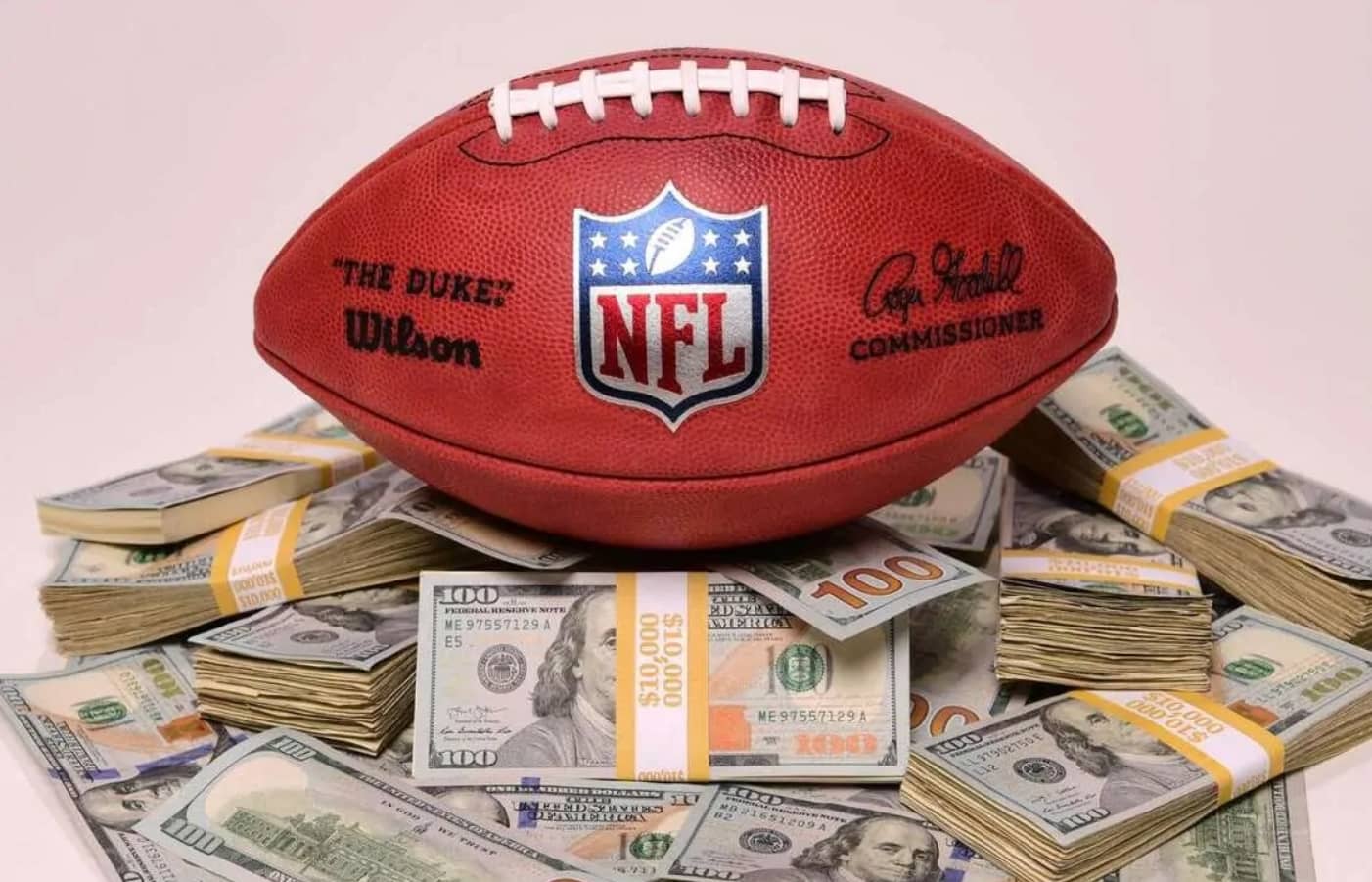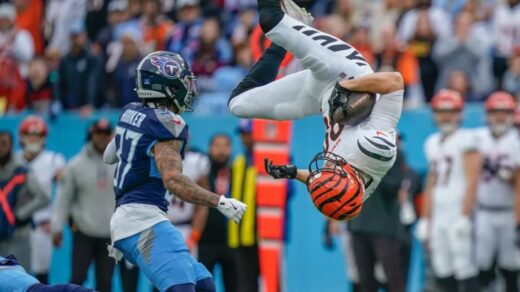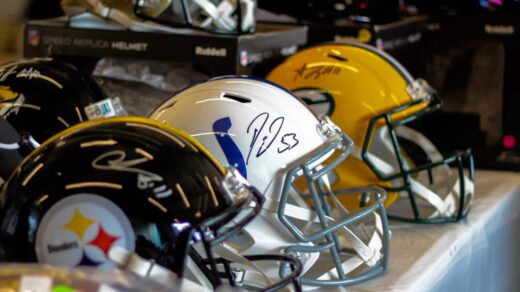Ever wonder how your favorite NFL team can finish with a dismal 5–12 record yet still rake in hundreds of millions of dollars?
While fans suffer through losing seasons, team owners rarely lose sleep over their bank accounts.
The NFL has built a bulletproof business model that guarantees profitability regardless of what happens on the field.
How NFL Teams Make Money?

In this article, you’ll discover exactly how NFL teams make money through massive TV contracts, lucrative sponsorships, merchandise sales, and a unique revenue-sharing system that keeps even the worst teams financially healthy.
Whether your team wins the Super Bowl or tanks for draft picks, the money keeps flowing.
Quick Answer: How Do NFL Teams Make Money?
NFL teams generate revenue through national television broadcasting deals worth over $110 billion, corporate sponsorships, merchandise licensing, ticket sales, and a league-wide revenue-sharing system.
This structure ensures all 32 teams remain profitable even during losing seasons, as most income comes from shared league revenues rather than individual team performance.
Understanding the NFL’s Unique Business Model
The NFL operates differently from most professional sports leagues. While individual team success matters for fan engagement, the league’s financial structure protects every franchise from serious losses.
At its core, the NFL uses a “revenue-sharing” approach. This means the biggest money-makers — TV deals, licensing agreements, and national sponsorships — get divided equally among all 32 teams.
Think of it like this: whether you’re the Super Bowl champion Kansas City Chiefs or the struggling Carolina Panthers, you get the same slice of the league’s biggest revenue pies.
Here’s what gets shared:
- National television broadcasting rights
- League-wide sponsorship deals
- Official NFL merchandise sales
- Licensing fees from video games and media
Here’s what teams keep locally:
- Individual ticket sales revenue
- Stadium concessions and parking
- Local radio and TV deals
- Team-specific sponsorships
| Revenue Type | Shared Among All Teams? | Example |
|---|---|---|
| National TV Rights | ✅ Yes | FOX, CBS, NBC, ESPN, Amazon |
| Merchandise Licensing | ✅ Yes | Jerseys, hats, collectibles |
| Ticket Sales | ⚠️ Partially | Stadium-based income |
| Local Sponsorships | ❌ No | Regional brand partnerships |
| Luxury Suites | ❌ No | Premium seating packages |
This system creates competitive balance and ensures financial stability across all markets, from massive cities like New York to smaller ones like Green Bay.
The Massive Power of TV and Media Deals
Television contracts form the financial backbone of the NFL. These deals are so massive that they guarantee every team receives over $300 million annually before selling a single ticket.
The current TV agreement, running from 2023 through 2033, is worth approximately $110 billion. That’s billion with a “B.”
Major broadcast partners include:
- CBS – AFC games and playoff coverage
- FOX – NFC games and Super Bowl rotation
- NBC – Sunday Night Football
- ESPN/ABC – Monday Night Football
- Amazon Prime Video – Thursday Night Football
- NFL Network – Select games and RedZone coverage
Each network pays billions for the right to broadcast games because NFL programming consistently delivers the highest television ratings in America. Even a mediocre Thursday night matchup between two losing teams can attract millions of viewers.
The beauty of this system? A team going 3–14 receives the same TV revenue share as the team winning the Super Bowl. Performance doesn’t affect this income stream at all.
Streaming platforms have also entered the game. Amazon’s deal for Thursday Night Football alone is worth about $1 billion per season, showing how digital media is expanding the NFL’s revenue sources beyond traditional television.
Sponsorships and Brand Partnerships Worth Billions
Corporate America loves the NFL because it delivers a passionate, engaged audience every single week. Major brands pay enormous sums to associate themselves with America’s most popular sport.
League-wide official sponsors include:
- Nike (apparel and uniforms)
- Pepsi (beverages)
- Verizon (telecommunications)
- Bud Light (alcoholic beverages)
- Visa (financial services)
- Microsoft (technology and surfaces)
These partnerships generate billions in revenue that gets distributed among all teams.
Stadium naming rights represent another massive revenue source. Companies pay premium prices to put their name on NFL venues for decades:
- SoFi Stadium (Los Angeles) – Over $600 million for 20 years
- Allegiant Stadium (Las Vegas) – $20-25 million annually
- MetLife Stadium (New Jersey) – $17-19 million per year
Beyond league-wide deals, individual teams secure local sponsorships with regional businesses. A car dealership in Dallas might pay the Cowboys millions to be their “official automotive partner.”
Local banks, restaurants, casinos, and retailers all compete for NFL team associations.
Jersey patches, introduced in recent years, provide yet another sponsorship opportunity.
Teams can now sell small advertising space on player uniforms, adding several million more to annual revenues.
Merchandise and Licensing: A Global Money Machine
Walk into any mall in America — or increasingly, anywhere in the world — and you’ll find NFL merchandise. Every jersey, hat, t-shirt, and collectible sold generates revenue for the league.
The NFL partners with companies like Fanatics and Nike to manufacture and distribute official merchandise globally. All sales revenue gets pooled together, then divided equally among the 32 teams.
This means when someone in Tokyo buys a Patrick Mahomes jersey, the Arizona Cardinals get a cut too.
Top-selling NFL teams by merchandise (recent years):
| Rank | Team | Reason for Popularity |
|---|---|---|
| 1 | Dallas Cowboys | National fanbase, historic brand |
| 2 | Kansas City Chiefs | Recent Super Bowl success, Mahomes |
| 3 | Philadelphia Eagles | Large market, passionate fans |
| 4 | San Francisco 49ers | Iconic brand, recent success |
| 5 | Green Bay Packers | Historic franchise, Lambeau mystique |
Even teams that don’t crack the top-10 in merchandise sales still benefit from the overall pool. The NFL’s licensing business generates over $3 billion annually, ensuring every franchise profits from the league’s global brand recognition.
Video games like Madden NFL also contribute licensing fees. Electronic Arts pays the NFL hundreds of millions for the exclusive right to produce simulation football games featuring real teams, players, and stadiums.
Ticket Sales, Stadium Revenue, and Game Day Income
While TV deals and sponsorships provide guaranteed income, game day operations offer teams additional local revenue opportunities.
Home game revenue streams include:
- Ticket sales (general admission, club seats, suites)
- Parking fees
- Concession sales (food and beverages)
- Stadium merchandise shops
- In-stadium advertising
Teams with newer, modern stadiums generate significantly more income than those in older facilities. Premium seating options like luxury suites and club sections can cost fans tens of thousands of dollars per season.
The Dallas Cowboys lead the league in stadium revenue, largely due to AT&T Stadium’s design. The venue features:
- 300+ luxury suites
- Multiple club seating levels
- The world’s largest HD video screen
- Year-round event hosting capabilities
Top NFL teams by stadium revenue (estimated annual):
| Rank | Team | Stadium | Capacity | Est. Stadium Revenue |
|---|---|---|---|---|
| 1 | Dallas Cowboys | AT&T Stadium | 80,000 | $620M+ |
| 2 | Las Vegas Raiders | Allegiant Stadium | 65,000 | $500M+ |
| 3 | Los Angeles Rams | SoFi Stadium | 70,000 | $480M+ |
| 4 | New England Patriots | Gillette Stadium | 65,000 | $450M+ |
| 5 | New York Giants | MetLife Stadium | 82,500 | $430M+ |
Smaller market teams or those with older stadiums generate less game day revenue but remain profitable thanks to shared league income.
Stadium owners also maximize profits by hosting non-football events like concerts, college games, soccer matches, and corporate events during the offseason.
The NFL Revenue Sharing System Explained Simply
The NFL’s financial structure is often called a “socialist model” — and it’s what makes the league so stable compared to other sports.
Here’s how it works: The NFL negotiates massive deals at the league level, then distributes that money evenly to all 32 teams. This creates parity and prevents wealthy franchises in big markets from dominating smaller-market teams financially.
Revenue sharing includes:
- National media rights – TV and streaming deals split equally
- NFL Ventures – League business initiatives distributed to all teams
- League-wide sponsorships – Official partners divided evenly
- Merchandise licensing – Pooled and shared across franchises
The Green Bay Packers are the perfect example of how this system works. Green Bay has a metro population of only about 320,000 people — smaller than most suburbs. Yet the Packers compete financially with teams in New York, Los Angeles, and Chicago.
Without revenue sharing, small-market teams would struggle to afford competitive rosters. The system ensures every franchise can spend up to the salary cap limit regardless of local market size.
The salary cap itself is tied to league revenues. As total NFL income grows, so does the cap. This prevents rich teams from simply buying championships while guaranteeing players receive approximately 48% of total league revenues.
Hidden Revenue Streams Most Fans Don’t Know About
Beyond the obvious income sources, the NFL profits from numerous additional ventures that add hundreds of millions to its annual revenues.
- NFL Films and Media Productions: The league’s in-house production company creates documentaries, highlight packages, and original content. This content gets licensed to networks, streaming services and generates subscription revenue through NFL+.
- International Games: The NFL hosts regular-season games in London, Frankfurt, and Mexico City. These games expand the global fanbase, create new sponsorship opportunities, and open international merchandise markets.
- NFL Draft and Combine Events: These annual spectacles generate ticket sales, sponsorship deals, and massive television ratings. The NFL Draft has become a multi-day primetime television event attracting millions of viewers.
- Digital Rights and Streaming: NFL+ (the league’s streaming service), YouTube highlights, social media partnerships, and mobile app revenues contribute to growing digital income streams.
- eSports and Gaming: Beyond Madden licensing, the NFL explores eSports tournaments, fantasy football partnerships, and sports betting integrations (where legal).
- Stadium Non-Football Usage: NFL venues host Super Bowls, college championship games, major concerts, WrestleMania events, and international soccer matches — all generating rental income for team owners.
The NFL’s business tentacles reach far beyond Sunday afternoon football games, creating a year-round revenue machine.
How do Losing Teams Still Make Massive Profits?
Team performance and revenue aren’t as connected as most fans assume. While winning teams might sell more local merchandise and tickets, the bulk of NFL income comes from shared league revenues.
Let’s look at some real examples:
| Team | Recent Record | Market Size | Estimated Annual Revenue |
|---|---|---|---|
| New York Jets | 7–10 (2023) | Large | $580M+ |
| Chicago Bears | 7–10 (2023) | Large | $550M+ |
| Washington Commanders | 8–9 (2023) | Large | $540M+ |
| Dallas Cowboys | 12–5 (2023) | Large | $1.1B+ |
| Kansas City Chiefs | 11–6 (2023) | Medium | $580M+ |
Notice something? The Jets and Bears, both with losing records, generated over $500 million annually. Their revenues stayed high because:
- They still received equal TV contract money – The biggest revenue source doesn’t care about wins and losses.
- Large market advantages – Teams in major cities benefit from bigger local sponsorship deals and higher ticket prices regardless of performance.
- Brand loyalty – Die-hard fans continue buying merchandise and attending games even during rebuilding years.
- Revenue sharing protections – The NFL’s system ensures no team falls below a profitable baseline.
Even consistently struggling franchises remain valuable business assets. When the Commanders sold in 2023, despite years of poor performance and controversy, they fetched $6.05 billion — an NFL record at the time.
The NFL’s structure essentially makes it impossible for teams to lose money unless ownership makes catastrophically bad business decisions unrelated to on-field performance.
The NFL’s Billion-Dollar Ecosystem: The Big Picture
Step back and look at the complete picture: The NFL generated approximately $18-20 billion in total revenue during recent seasons. That number continues climbing annually.
This isn’t just a sports league — it’s a meticulously designed business empire that:
- Negotiates billion-dollar TV deals
- Partners with America’s biggest corporations
- Sells merchandise on six continents
- Creates year-round content and events
- Expands into new markets and platforms
- Maintains competitive balance through revenue sharing
- Protects profitability through collective bargaining
The salary cap, draft system, and schedule creation all work together to maintain unpredictability on the field while ensuring predictable profits off it.
Owners invest hundreds of millions (or billions) to buy teams not because they’re football fanatics, but because NFL franchises are virtually guaranteed to appreciate and generate steady returns.
The NFL has achieved what few businesses ever do: near-total market dominance in its category with built-in protections against failure.
Frequently Asked Questions
- Do all NFL teams actually make a profit every year?
Yes, virtually all NFL teams operate profitably due to revenue sharing and guaranteed TV contract money. Poor business management off the field is the only real threat to profitability, not losing games.
- Who owns the most valuable NFL team?
The Dallas Cowboys are consistently valued as the most valuable NFL franchise, worth approximately $9 billion according to recent estimates. Their combination of national brand recognition and stadium revenue generation makes them the league’s financial leader.
- How much does each NFL team make from TV deals?
Each team receives over $300 million annually from national TV contracts alone. This number increases as new broadcasting deals are negotiated, with the current agreement running through 2033.
- Do NFL players get paid if their team loses games?
Yes, players receive their contracted salaries regardless of team performance. NFL contracts are guaranteed to varying degrees, but game outcomes don’t affect regular salary payments. Players can earn additional bonuses for playoff appearances and championships.
- Why is the NFL richer than other sports leagues?
The NFL’s combination of limited supply (only 17 regular-season games), massive TV ratings, passionate fanbase, revenue sharing, and effective marketing makes it America’s most profitable sports league. Football’s once-per-week schedule also creates appointment viewing that commands premium advertising rates.
- Can small-market teams compete financially with big-market teams?
Yes, due to revenue sharing. The NFL’s system ensures teams in Green Bay, Buffalo, and Jacksonville receive the same TV and licensing money as teams in New York, Los Angeles, and Chicago. Local revenues vary, but the salary cap prevents spending disparities from creating competitive imbalances.
Conclusion:
The NFL’s financial success isn’t about touchdowns, playoff wins, or championship trophies — at least not entirely.
It’s about a brilliantly constructed business model that guarantees profitability regardless of what happens between the white lines.
Through massive TV contracts, corporate partnerships, merchandise sales, and a unique revenue-sharing system, even the worst NFL teams remain money-making machines.
So next time your team goes 4–13 and misses the playoffs again, remember this: their record might be terrible, but their bank account is doing just fine.
Share this article with fellow fans who wonder how struggling franchises stay alive.
Understanding the business side of football adds a whole new dimension to being an NFL fan.



